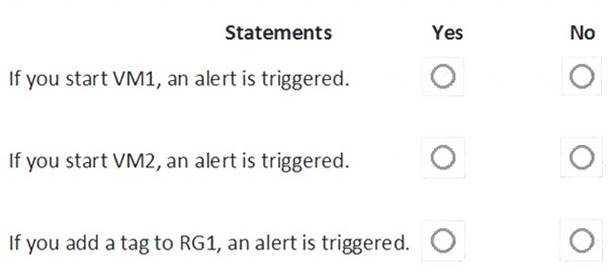- (Exam Topic 4)
You create an alert rule that has the following settings:  Resource: RG1
Resource: RG1 Condition: All Administrative operations
Condition: All Administrative operations Actions: Action groups configured for this alert rule: ActionGroup1
Actions: Action groups configured for this alert rule: ActionGroup1  Alert rule name: Alert1
Alert rule name: Alert1
You create an action rule that has the following settings:  Scope: VM1
Scope: VM1 Filter criteria: Resource Type = "Virtual Machines"
Filter criteria: Resource Type = "Virtual Machines"  Define on this scope: Suppression
Define on this scope: Suppression Suppression config: From now (always)
Suppression config: From now (always)  Name: ActionRule1
Name: ActionRule1
For each of the following statements, select Yes if the statement is true. Otherwise, select No. Note: Each correct selection is worth one point.
Solution:
Box 1:
The scope for the action rule is set to VM1 and is set to suppress alerts indefinitely.
Box 2:
The scope for the action rule is not set to VM2. Box 3:
Adding a tag is not an administrative operation. References:
https://docs.microsoft.com/en-us/azure/azure-monitor/platform/alerts-activity-log
https://docs.microsoft.com/en-us/azure/azure-monitor/platform/alerts-action-rules
Does this meet the goal?
Correct Answer:
A
- (Exam Topic 4)
You have an Azure web app named webapp1.
You need to configure continuous deployment for webapp1 by using an Azure Repo.
What should you create first?
Correct Answer:
B
- (Exam Topic 4)
You have an Azure subscription named Sub1.
You have an Azure Active Directory (Azure AD) group named Group1 that contains all the members of your IT team.
You need to ensure that the members of Group1 can stop, start, and restart the Azure virtual machines in Sub1. The solution must use the principle of least privilege.
Which three actions should you perform in sequence? To answer, move the appropriate actions from the list of actions to the answer area and arrange them in the correct order.
Solution:
References:
https://www.petri.com/cloud-security-create-custom-rbac-role-microsoft-azure
Does this meet the goal?
Correct Answer:
A
- (Exam Topic 4)
Your company has an Azure subscription named Sub1 that is associated to an Azure Active Directory (Azure AD) tenant named contoso.com.
The company develops an application named App1. App1 is registered in Azure AD.
You need to ensure that App1 can access secrets in Azure Key Vault on behalf of the application users. What should you configure?
Correct Answer:
B
Delegated permissions - Your client application needs to access the web API as the signed-in user, but with access limited by the selected permission. This type of permission can be granted by a user unless the permission requires administrator consent.
- (Exam Topic 4)
Note: This question is part of a series of questions that present the same scenario. Each question in the series contains a unique solution that might meet the stated goals. Some question sets might have more than one correct solution, while others might not have a correct solution.
After you answer a question in this section, you will NOT be able to return to it. As a result, these questions will not appear in the review screen.
You have an Azure subscription named Sub1.
You have an Azure Storage account named Sa1 in a resource group named RG1.
Users and applications access the blob service and the file service in Sa1 by using several shared access signatures (SASs) and stored access policies.
You discover that unauthorized users accessed both the file service and the blob service. You need to revoke all access to Sa1.
Solution: You create a lock on Sa1. Does this meet the goal?
Correct Answer:
B
To revoke a stored access policy, you can either delete it, or rename it by changing the signed identifier. Changing the signed identifier breaks the associations between any existing signatures and the stored access policy. Deleting or renaming the stored access policy immediately affects all of the shared access signatures associated with it.
References:
https://docs.microsoft.com/en-us/rest/api/storageservices/Establishing-a-Stored-Access-Policy